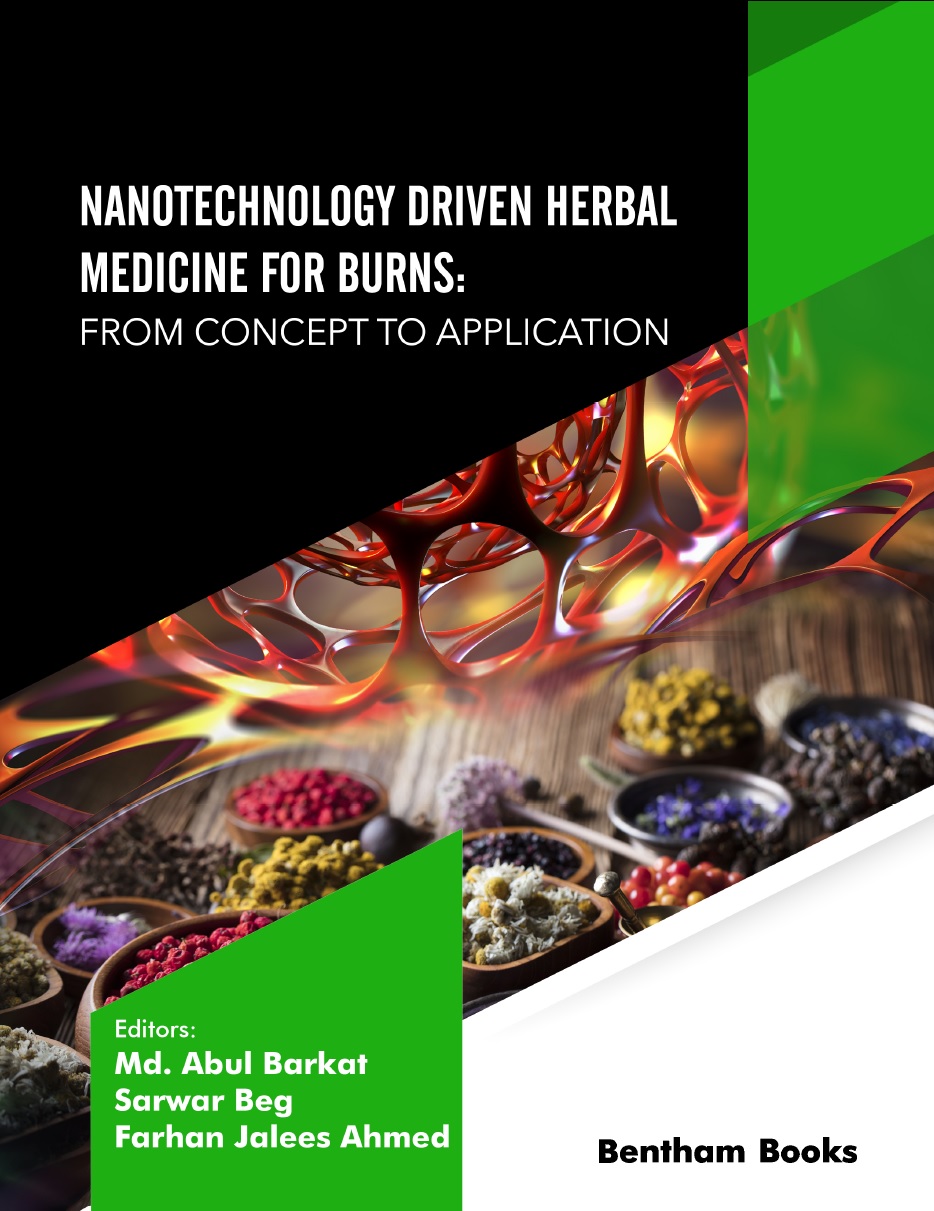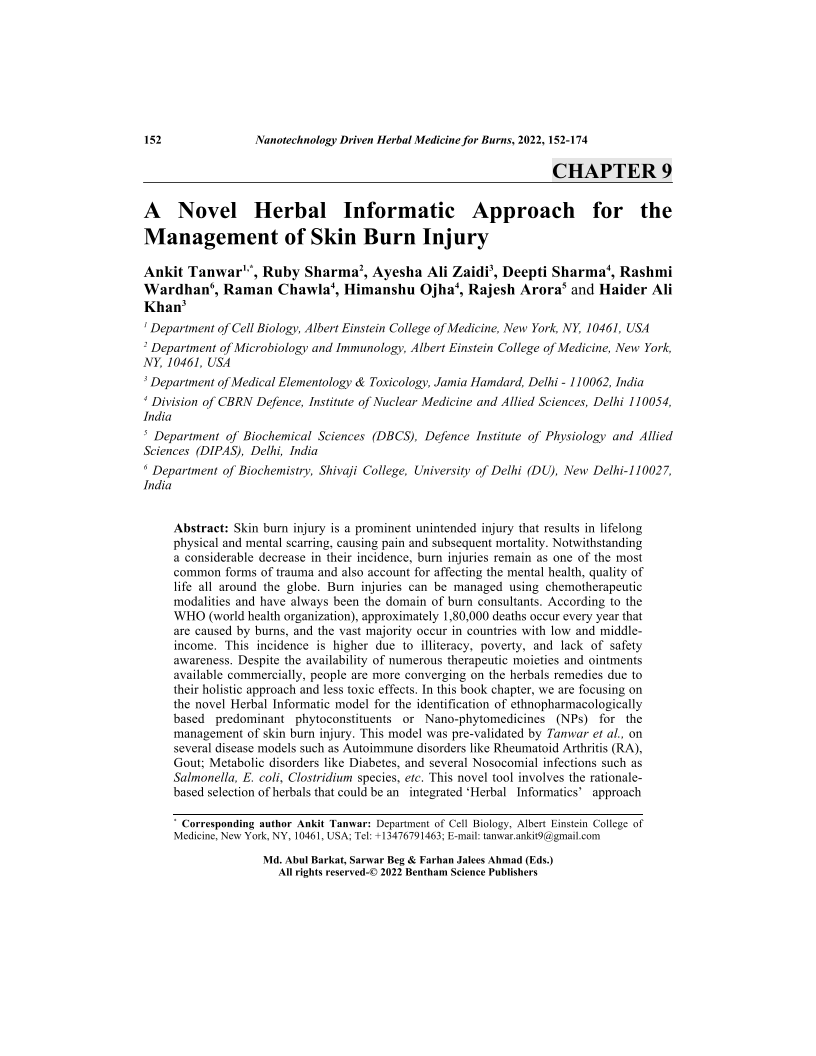A Novel Herbal Informatic Approach for the Management of Skin Burn Injury

- Authors: Ankit Tanwar1, Ruby Sharma2, Ayesha Ali Zaidi3, Deepti Sharma4, Rashmi Wardhan5, Raman Chawla6, Himanshu Ojha7, Rajesh Arora8, Haider Ali Khan9
-
View Affiliations Hide AffiliationsAffiliations: 1 Department of Cell Biology, Albert Einstein College of Medicine, New York, NY, 10461, USA 2 Department of Microbiology and Immunology, Albert Einstein College of Medicine, New York, NY, 10461, USA 3 Department of Medical Elementology & Toxicology, Jamia Hamdard, Delhi 110062, India 4 Division of CBRN Defence, Institute of Nuclear Medicine and Allied Sciences, Delhi 110054, India 5 Department of Biochemistry, Shivaji College, University of Delhi (DU), New Delhi-110027, India 6 Division of CBRN Defence, Institute of Nuclear Medicine and Allied Sciences, Delhi 110054, India 7 Division of CBRN Defence, Institute of Nuclear Medicine and Allied Sciences, Delhi 110054, India 8 Department of Biochemical Sciences (DBCS), Defence Institute of Physiology and AlliedSciences (DIPAS), Delhi, India 9 Department of Medical Elementology & Toxicology, Jamia Hamdard, Delhi - 110062, India
- Source: Nanotechnology Driven Herbal Medicine for Burns: From Concept to Application , pp 152-174
- Publication Date: December 2021
- Language: English
A Novel Herbal Informatic Approach for the Management of Skin Burn Injury, Page 1 of 1
< Previous page | Next page > /docserver/preview/fulltext/9789815039597/chapter-9-1.gif
Skin burn injury is a prominent unintended injury that results in lifelong<br>physical and mental scarring, causing pain and subsequent mortality. Notwithstanding<br>a considerable decrease in their incidence, burn injuries remain as one of the most<br>common forms of trauma and also account for affecting the mental health, quality of<br>life all around the globe. Burn injuries can be managed using chemotherapeutic<br>modalities and have always been the domain of burn consultants. According to the<br>WHO (world health organization), approximately 1,80,000 deaths occur every year that<br>are caused by burns, and the vast majority occur in countries with low and middleincome.<br>This incidence is higher due to illiteracy, poverty, and lack of safety<br>awareness. Despite the availability of numerous therapeutic moieties and ointments<br>available commercially, people are more converging on the herbals remedies due to<br>their holistic approach and less toxic effects. In this book chapter, we are focusing on<br>the novel Herbal Informatic model for the identification of ethnopharmacologically<br>based predominant phytoconstituents or Nano-phytomedicines (NPs) for the<br>management of skin burn injury. This model was pre-validated by Tanwar et al., on<br>several disease models such as Autoimmune disorders like Rheumatoid Arthritis (RA),<br>Gout; Metabolic disorders like Diabetes, and several Nosocomial infections such as<br>Salmonella, E. coli, Clostridium species, etc. This novel tool involves the rationalebased<br>selection of herbals that could be an integrated Herbal Informatics approach employing the use of both ethnopharmacological/traditional knowledge from the<br>Ayurvedic Medicinal System (AMS) and in silico bio-informatics search tools. This<br>combinatorial approach serves to retrieve information about a plant and reveals their<br>phytoconstituents based on medicinal properties for targeting virulence<br>factors/biomarkers involved in the progression of burn injury. In this chapter, we are<br>emphasizing the 5-major steps that are involved in scrutinizing the robust druggable<br>natural compounds that could be utilized to develop Nano-phytomedicines (NPs) for<br>the management of skin burn injury or burn sepsis and can also be effective in the drug<br>discovery process followed by study at in vitro and in vivo level.<br>
-
From This Site
/content/books/9789815039597.chapter-9dcterms_subject,pub_keyword-contentType:Journal105

